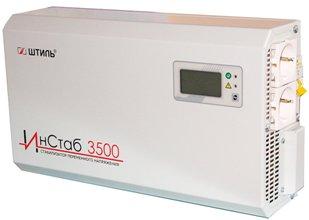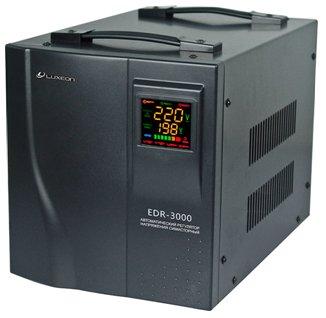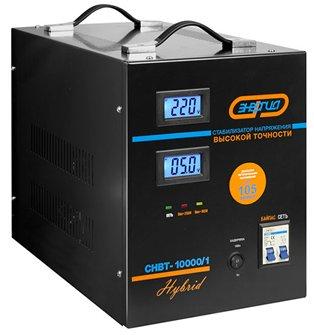Many owners of private houses and apartments are faced with the problem of instability of the electrical network. It is recommended to quickly resolve such a defect in order to save the equipment from rapid failure. Breakdowns can occur as a result of insufficient or high voltage in the network, which creates problems during the operation of devices, as well as shortens their service life. For protection against drops and the possibility of full use of technology, it is recommended to use a stabilizer. At the moment, there are several types of devices and it is important to understand which one to choose a 220V voltage stabilizer, because they differ in the type of technology.
Content
The principle of operation of the voltage stabilizer and its design
At the heart of many voltage stabilizers is a high-power transformer, which helps the entire system work. Based on the method of adjusting the current and other features of products, 2 categories of technology can be distinguished: electromechanical and electronic.
Electromechanical stabilizers are considered servomotors. The main control element analyzes the incoming currents, and based on the value, begins to change it, the servo drive makes a turn at a certain angle. In the event of a change in the position of the drive, the carriage on it begins to move the brush on the transformer winding. That allows you to change the output current.
Electronic devices work a little differently. The incoming current that comes to the board is taken into account, after which the switching on or off of the secondary winding section begins. Switching is carried out via a relay or using semiconductor switches.
The transformerless circuit is characterized by the use of an inverter stabilizer. An alternating current that enters the apparatus starts flowing through a frequency filter. After that, through a rectifier and correctors, it is converted into a constant and stored in capacitors. In the future, the current goes to the inverter, the generator, allowing for a new conversion of alternating currents with almost ideal values.
Types of voltage stabilizers
To figure out how to choose a voltage stabilizer for your home, you need to understand the pros, cons and features of each type. They differ in their constructive and operating principle.
Relay

These models are in great demand due to their affordable pricing policy and excellent performance parameters. The average price is in the range of 1500-55000 rubles. It is recommended to use a similar unit for equipment of low power. Often they buy for a boiler, computer and it is recommended to use a stabilizer for networks where there are relatively calm jumps.
This type of unit is characterized by a stepwise adjustment of the output voltage, the step of which is 5-20V. This can affect the operation of lighting in the form of flickering bulbs, so it is not recommended to connect the device for lighting systems.In the case of an error of 3% or more, changes during normalization of the current will be reflected by glare visible to the eyes.
The design includes several relays, the accuracy of the setting will depend on their numerical indicator. With an increase in the number of such elements, the frequency of their operation increases, which is complemented by minimal current fluctuations in the network. Often, the demanded models include 4 relays, and the total error is 8%. To reduce the percentage, 6 relays are placed in the structure.
Pros:
- High speed of work and stabilization, which is 100-200V / sec.
- Strong overload capacity, which helps to use machinery with high starting current.
- Possibility of using the stabilizer at different ambient temperatures from -30 to +40 degrees.
- Small size and weight.
Minuses:
- During operation, a gradual wear of the relays begins, with an average operating period of 10 years, but much depends on the mode of use and the quality of the parts.
- The speed of work directly depends on the error.
- The design features are such that there are many switching connections inside, which degrade the overall system reliability.
Electromechanical

A similar technique is recommended for use for a network where there are no sudden voltage changes, but the indicators are always more or less than the norm. The operation of such a stabilizer will be optimal for lighting devices with current instability. The work is performed with high precision, which helps to protect audio equipment, measuring devices. Some companies supplement the entire design with a pair of graphite brushes, which allows for faster current stabilization to normal limits.
The average cost of such equipment is in the range of 2-52 thousand rubles, if we consider devices for 0.5-15 kVA.
Pros:
- The minimum error is within 2-3%.
- The technique is resistant to increased loads, it can withstand sharp surges for about 3 seconds, at which the rated current will be twice as high.
- The current regulation is smooth.
- Any required current can be obtained at the output.
- Minimal noise if there are no drops in the network.
Pros:
- Due to the motor, the speed of the brush is regulated, which means that the speed of the device's reaction to changes in the network can change, which will be about 10-15 V / sec.
- Moving parts need to be replaced periodically due to wear and tear. The average service life of graphite brushes is 3-5 years, but the servo drive will work for 5-7 years.
- Technique of increased power, therefore, the mass and dimensions are large
- The ability to work in a small temperature range, which is from -5 to +40 degrees.
- It is recommended to carry out routine inspection and diagnostics every year to keep the stabilizer working properly.
- During the stabilization itself, a characteristic sound appears in the network.
Inverter converter

These types of voltage stabilizers are considered one of the most modern and innovative. They contain the optimal parameters that are not found in other types of devices. The technique can be used for a private house, apartment and protection of any device. The unit is suitable for boiler automation, pumping equipment, household appliances. The stabilizer provides the current with maximum accuracy without time delays. Modern solutions and the positive aspects of the device affect the cost, therefore, you will need to pay 6.5-150 thousand rubles for such equipment.
Pros:
- Small dimensions as no transformer is installed inside.
- Eliminates impulse noise in the network.
- Output parameters at a high level when changing in the network at the output of 115-300V. There will be no more than 15 deviation from the normal value at 220V.
Minuses:
- Very high cost of the device.
- Electronic elements require cooling during use, so small fans are used to solve the problem, which have a little noise during operation.
Thyristor (triac)

Such devices are similar to blocks and are characterized by identical operation of relay models, but they have a higher performance and speed of stabilization of the power grid. The tuning accuracy is 4-10%, and the specific indicator depends on the number of windings on the transformer. The technique is perfect for a refrigerator, washing machine or electric stove, as well as other appliances that have heating elements or electric motors.
The device includes digital control, all parts are located on the main board. With the help of a display built into the case, a person can see data on the input and output currents. The average cost of the device is from 1.5 to 65 thousand rubles.
Pros:
- There are no moving parts in the design of the stabilizer, which completely eliminates the problem of component wear.
- Durability and high degree of reliability.
- Certain devices are suitable for operation in frost at -20 degrees.
- Wide operating range, which allows you to work with different input voltages.
- Do not interfere with the network during operation.
Minuses:
- For accurate tuning, many steps must be used, which can negatively affect speed.
- Devices almost cannot withstand overload, in the case of a strong load there is a possibility of a short circuit, disabling the electronic keys.
- It is difficult to carry out repairs when the device breaks down
- High price.
Combined

Such a device can be used for any appliances that are used at home, suitable for a refrigerator and other appliances. It has a combined system of relay and electromechanical converters inside. Voltage adjustments are performed smoothly or using a step system, based on the input indicators. In the event of a sharp decrease in the current in the network or its strong surges, the relay part will be activated, since it is important to take quick action. If the current strength is closer to normal, then the servo motor starts to connect. Depending on the power of the device, it is necessary to pay 2.5-70 thousand rubles for the combined stabilizer.
Pros:
- High stabilization accuracy in the range of 2-3%.
- It can function under significant loads.
- The adjustments are smooth.
- The response speed is fast.
Minuses:
- The relay is mechanically worn out, and the brushes inside require periodic replacement.
- Overpriced product.
Top voltage regulator manufacturers
You can choose the right stabilizer if you understand the main features and types. In order not to go into the study of the parameters, you can simply use goods from trusted manufacturers, which are domestic and import companies. The best representatives at the moment are:
- APC;
- RUCELF;
- Defender;
- Lider;
- Resant.
The described brands offer a wide range of stabilizers for various purposes and types. All equipment is characterized by high quality and reliability.
The main parameters for choosing a voltage stabilizer
Many models of voltage stabilizers are suitable for home use. In order to accurately determine the choice, it is important to determine several factors. Initially, you should understand the technology that will be connected, the scope of use (private house, apartment or summer cottage).
Phase
Buyers often face the problem of the phasing of the device, because there are models for 3 or 1 phase. This question appears more often in people who use a three-phase network, since with a single-phase system, the choice will be obvious. In the first case, single-phase devices can be used to exclude the shutdown of the entire system in the event of a loss of current in one of the phases.
Ideally, it is recommended to install 1 stabilizer for each phase, which will be cheaper than buying one three-phase model. The last option can be useful only if at least 1 three-phase consumer is installed in the house.
Power
You can choose the right unit only based on the power of all equipment that will be connected to the stabilizer. To do this, you need to add up all the amounts, and the total value can be 3-4 times more than the total power. Any manufacturer of stabilizers provides a passport to the device, which indicates the power.
Stabilized voltage range
Any type of technique described is used exclusively for converting current within certain limits. For example, the range for domestic conditions is 130-270V. If the indicator goes beyond the limits, all devices in the house connected to the stabilizer will be turned off.
It will only take several days to make an accurate calculation of the range. To do this, you need to analyze the indicators for several days during peak hours. As a result, the necessary calculation is made, the equipment is selected that fully satisfies the needs in terms of technical parameters.
Stabilization accuracy
For optimal protection of household appliances, when choosing a stabilizer, it is necessary to take into account the maximum range of differences that need to be protected. If the technique is used for lighting technology, then the accuracy should be from 3%. This eliminates the flickering of light bulbs, even in the event of a sharp change in the current in the network. Many appliances for home use are able to function normally with changes in the electrical network in the region of 5-7%.
Installation method
The choice of installation depends on personal preference. All stabilizers are floor or wall mounted. When choosing a place, you should take into account the small amount of space that will be required for cooling and fan operation.
One or more stabilizers?
It is best to use a separate regulator for each device for reliable protection against power surges. The choice is made according to power and accuracy. To save money, it is recommended to connect several electrical consumers to 1 unit at once, calculating the total power. In this case, stabilization can be carried out for expensive and important equipment, and all other types of devices that have optimal protection or insensitivity to voltage surges will remain without being connected to the stabilizer.
Which voltage regulator to choose
Voltage stabilizers should be selected based on the tasks that the equipment will perform. Experts advise you to pay attention to the following parameters before buying:
- A relay or inverter device with a power of 0.5 kVA can protect a computer or TV from surges.
- Electromechanical devices with different power, depending on the technology, will be suitable for a summer residence where there are no valuable household appliances.
- Combined models for 10 kVA are recommended to be installed in a country house or in an apartment to power a large number of equipment.
- Electromechanical options for 15 kVA with 3 phases are an excellent choice for a country house where a 380V network is used.
- A thyristor or relay type of 1 kVA or less is recommended for a boiler intended for heating using gas.
It should also be borne in mind that electromechanical options are not used for boilers, since the brushes will spark when in contact with the transformer, which increases the risk of fire. Having studied all the features, anyone with problems in the electrical network of their home will be able to choose the right stabilizer for one technique or all equipment.



